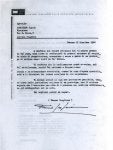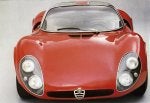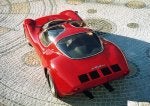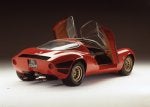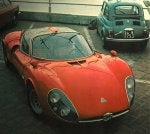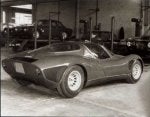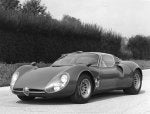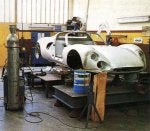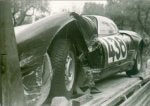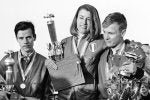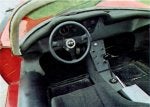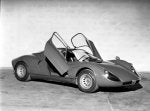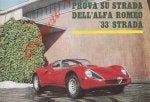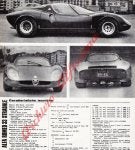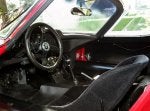interview Chiti & Zeccoli
La 33 stradale raccontata da Chiti e Zeccoli.
Avevamo un'auto da corsa che vinceva e un motore otto cilindri a V che poteva essere facilmente adattato all'uso stradale: non potevamo lasciarci scappare l'occasione di creare una Gran Turismo derivata direttamente da una macchina da competizione, che desse immagine e spessore a tutta la gamma della Casa. E che avrebbe rappresentato, tra l'altro, la migliore risposta dell'Alfa Romeo alla Fiat Dino 2000, la coupé torinese nata l'anno precedente proprio per offrire il meglio dell’esperienza delle corse (il motore V6 Ferrari addomesticato per l'uso stradale) su una macchina di serie. Carlo Chiti guarda le fotografie in bianco e nero sparse sul piano della sua scrivania alla Motori Moderni, appena fuori Novara, e ripensa a quei ruggenti anni 60 passati all'Autodelta, alle porte di Milano. Ruggenti non solo per il boom economico o per la scoperta di un'inedita generazione attiva in politica, quella dei teenager, ma anche perché alla presidenza dell'Alfa Romeo c'era Giuseppe Luraghi («il miglior presidente che l’Alfa abbia mai avuto», confessa Chiti), un uomo che amava le sfide difficili.
In questo clima di rinnovamento e innovazione nacque la 33 Stradale, una vettura prevista in 50 esemplari e poi costruita in soli 18 pezzi. Un'impresa contraddittoria nell’anno che vide la luce della 1750, berlina costruita in 101.880 unità. Ma contraddittorio era anche Giuseppe Luraghi, uno spirito libero.
Circuito di Monza, settembre '67, Mostra delle vetture sportive: debutta con le luci della ribalta brianzola la sportiva dell'Autodelta che vola sospesa nell'aria dalle vittorie della 33/2, il prototipo che al debutto sulla salita del Fléron, con Teodoro Zeccoli alla guida, riporta lo scudetto delle Alfa da corsa sul primo gradino del podio, dopo 14 armi di astinenza dalle corse e dall'assolo della 6C 3000 CM. Tre uomini le fanno scudo: Giuseppe Luraghi; Carlo Chiti, direttore defl'Autodelta e padre spirituale del telaio e del motore della 33 corsa; Franco Scaglione, autore del disegno e della realizzazione della carrozzeria della 33 Stradale, conosciuta infatti anche come Coupé Scaglione, un uomo controcorrente.
Ma come nacque la 33 Stradale? Racconta ancora Chiti: «Luraghi scelse uno dei bozzetti che aveva disegnato Scaglione e mi disse: 'costruiamola". Facemmo tutto all'Autodelta, a Settimo Milanese. Il telaio e il motore erano, a parte qualche modifica, gli stessi della 33 da corsa; la carrozzeria dei primi due esemplari, in alluminio, venne modellata nello stesso reparto dove si montavano i motori per le competizioni, con Scaglione che dirigeva i battilastra prestati da Zagato su come si doveva modellare il nuovo materiale. La 33 Stradale nacque in pochi mesi, da gennaio a novembre era tutto finito, dagli incontri per definire le linee della vettura insieme a Scaglione, che avevo scelto perché era specializzato nel disegnare Gran Turismo da sogno, alle prove di Zeccoli a Balocco. Nel marzo di due anni dopo, nel '69, l'ultima 33 Stradale usciva dalla carrozzeria Marazzi di Saronno, che vesti gli autotelai dalla terza alla diciottesima vettura. Avrebbero dovuto essere 50 ...». Conferma tutto Teodoro Zeccoli, collaudatore principe dell'Autodelta e pilota dall’invidiabile palmares sulle Sport Alfa Romeo. «La 33 Stradale? Ebbe la Montreal come nemica, che le venne preferita perché il progetto della coupé sportiva a motore anteriore era costato troppi investimenti per rinunciarvi all’ultimo momento. E perché la querelle tra il Reparto Esperienze dell'Alfa e l'Autodelta non era ancora finita. Probabilmente, se non ci fosse stata questa disputa forse Luraghi sarebbe riuscito a far prevalere la 33 anche nei saloni della direzione oltreché su strada e su pista. Preferire la Montreal alla 33 Stradale fu uno degli errori più gravi dell'Alfa di quegli anni, una disfatta, perché la Montreal (presentata all'Esposizione universale canadese del'67 e prodotta solo a partire dal '71) era solo bella da vedersi ma in movimento era un disastro. Il telaio era completamente sbagliato: acceleravo e il muso si impennava, frenavo e strisciava per terra. E cambiare molle e barre di torsione non serviva a niente. Con la 33 Stradale invece era tutta un'altra cosa. Era la stessa vettura che correva, soltanto addolcita nel motore, nello sterzo meno diretto e nella tenuta di strada. Tanto che qualcuno, come la concessionaria Scar Autostrada di Firenze con Spartaco Dini, la usò anche in corsa. A Balocco raggiungevo i 260 orari e la guidavo con una facilità disarmante. Il motore poi aveva un'affidabilità invidiabile: le 24 Ore che abbiamo portato a termine sono lì a dimostrarlo. E per quanto riguardava le vendite non c'erano problemi, la 33 Stradale piaceva: lo Scià di Persia ne aveva una, come anche il conte Corrado Agusta, al quale la consegnai personalmente, e Susy Raganelli, la campionessa di kart». Per meccanica e aerodinamica la 33 Stradale era ai vertici delle due posti sportive. L'otto cilindri a V di 90°, con quattro alberi a camme in testa, montava per la versione stradale l'iniezione Spica invece che Lucas, particolari in alluminio invece che in magnesio, fasature delle camme ed a bassa alzata ed aveva perso una cinquantina di cavalli. La potenza specifica di 115 cavalli/litro, comunque, era la più alta tra i motori stradali: 700 kg di peso e 230 cavalli a 8.800 giri al minuto consentivano un’accelerazione da 0 a 100 orari in 4,9 secondi e una velocità massima dichiarata di 260 chilometri orai, vicina alla versione da competizione Fléron che registrava 274 orari. Merito, certo, anche della linea profilatissima, della coda lunga che favoriva la penetrazione nell'aria, come fin dall'inizio dimostrarono le prove con i fili di lana a Balocco. L'obiettivo iniziale era di costruire una vettura con il minimo compromesso per abitabilità e comfort e che avesse almeno il 95 per cento delle prestazioni dello spider da corsa. Il passo venne allungato di dieci centimetri, e i tubi centrali del telaio erano costruiti in acciaio saldato invece che in alluminio chiodato come sulla versione corsa. Il magnesio venne sostituito con l'alluminio: nei cerchi, più stretti, e nella scatola del cambio, a sei rapporti. Peraluman al posto della vetroresina per la carrozzeria, «perché era più bello a vedersi e perché anche le altre GT erano in lega d'alluminio», spiega Chiti. All'interno un abitacolo spartano, senza nemmeno lo Spazio per i bagagli, visto che il baule anteriore era occupato completamente dalla ruota di scorta. Alta solo 990 millimetri, la 33 Stradale impose a Scaglìone la soluzione delle porte incernierate diagonalmente, una raffinatezza forse inedita per risolvere il problema dell’accesso a bordo, complicato dai due longheroni principali che correvano nei sottoporta. Il prezzo di 10 milioni di lire su strada equivaleva a quello delle Aston Martin Volante e della Mercedes 600 Limo, mentre la Ferrari più costosa, la 365 Coupè, era sotto di due milioni.


